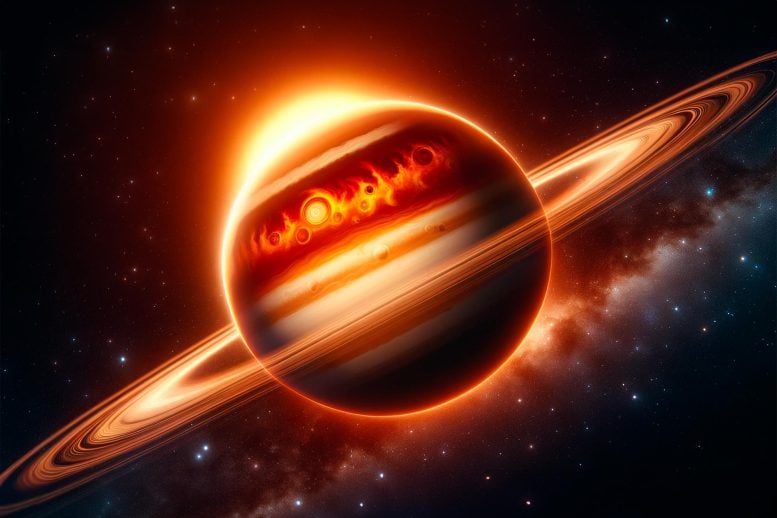
Astronomers analyzed HAT-P-18 b using the James Webb Space Telescope, revealing water vapor and CO2 in its atmosphere. They highlighted the challenges of distinguishing between atmospheric and stellar signals, suggesting that star spots significantly influence data interpretation. (Artist’s concept.) Credit: SciTechDaily.com
Astronomers used the JWST to study the atmosphere of the exoplanet HAT-P-18 b, finding water vapor and CO2 while emphasizing the impact of the host star’s characteristics on data analysis.
Led by researchers from Université de Montréal’s Trottier Institute for Research on Exoplanets (iREx), a team of astronomers has harnessed the power of the revolutionary James Webb Space Webb Telescope (JWST) to study the “hot Saturn” exoplanet HAT-P-18 b.
Their findings, published last month in the journal Monthly Notices of the Royal Astronomical Society, paint a complete picture of the HAT-P-18 b’s atmosphere while exploring the great challenge of distinguishing its atmospheric signals from the activity of its star.
HAT-P-18 b is located over 500 light-years away with a mass similar to Saturn’s but a size closer to that the larger planet Jupiter. As a result, the exoplanet has a “puffed-up” atmosphere that is especially ideal for analysis.
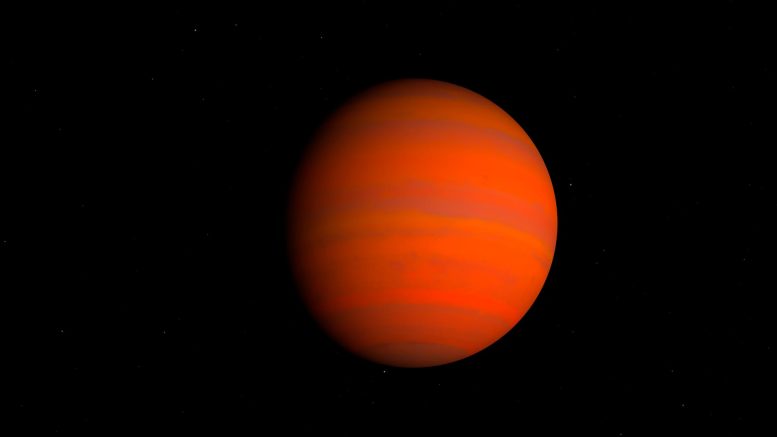
An artistic representation of the “hot Saturn” exoplanet, HAT-P-18 b. Credit: NASA/Eyes on Exoplanets
Passing Over a Spotted Star
Observations from the JWST were taken while the HAT-P-18 b was passing in front of its Sun-like star. This moment is called a transit and is crucial to detect and further characterize an exoplanet from hundreds of light-years away with surprising precision.
Astronomers don’t observe light that is being emitted directly by the distant planet. Rather, they study how the central star’s light is being blocked and affected by the planet orbiting it, and so must try to disentangle signals caused by the presence of the planet from those caused by the star’s own properties.
The light curve shows the luminosity or brightness of the star over time. When the exoplanet passes over the star, known as a transit, part of the star’s light is blocked by the exoplanet. As a result, the star’s luminosity decreases. When a star spot is occulted on the star’s surface, or when the exoplanet passes over the dark spot, astronomers can see a signal in the light curve in the form of a small bump in the bottom of the transit light curve. See the full animation of this infographic below. Credit: B. Gougeon/Université de Montréal
Just like our Sun, stars do not have uniform surfaces. They can have dark star spots and bright regions, which can create signals that mimic a planet’s atmospheric attributes. A recent study of the exoplanet TRAPPIST-1 b and its star TRAPPIST-1 led by UdeM doctoral student Olivia Lim witnessed an eruption, or flare, on the surface of the star, which affected observations.
In the case of planet HAT-P-18 b, Webb caught the exoplanet right as it was passing over a dark spot on its star, HAT-P-18. This is called a spot-crossing event, and its effect was evident in the data collected for the new study. The iREx team also reported the presence of numerous other star spots on HAT-P-18’s surface which were not blocked out by the exoplanet.
To accurately determine the exoplanet’s atmospheric composition, the researchers had to simultaneously model the planet’s atmosphere as well as its star’s peculiarities. In their study, they point out that such consideration will be crucial in treating future exoplanet observations via the Webb to fully harness their potential.
“We found that accounting for stellar contamination implies the existence of spots and clouds instead of haze and recovers a water vapour abundance of almost an order of magnitude lower,” said lead author Marylou Fournier-Tondreau.
“So considering the system’s host star makes a big difference,” added Fournier-Tondreau, who did the work as a master’s student at iREx and is now pursuing a Ph.D. at the University of Oxford.
“It’s actually the first time that we clearly disentangle the signature of hazes versus starspots, thanks to Canada’s NIRISS (Near-Infrared Imager and Slitless Spectrograph) instrument, which provides wider wavelength coverage extending into the visible light domain.”
H2O, CO2, and Clouds in a Scorching Atmosphere
After modeling the exoplanet and the star in the HAT-P-18 system, the iREx astronomers performed a meticulous dissection of HAT-P-18 b’s atmospheric composition. By inspecting the light that filters through the exoplanet’s atmosphere as it transits its host star, the researchers discerned the presence of water vapor (H2O) and carbon dioxide (CO2).
The researchers also detected the possible presence of sodium and observed strong signs of a cloud deck in HAT-P-18 b’s atmosphere, which appears to be muting the signals of many of the molecules found within it. They also concluded that the star’s surface was covered by many dark spots that can significantly influence the interpretation of the data.
An earlier analysis of the same JWST data led by a team at Johns Hopkins University had also revealed a clear detection of water and CO2, but also reported the detection of small particles at high altitudes called hazes and found hints of methane (CH4). The iREx astronomers paint a different picture.
The CH4 detection was not confirmed, and the water abundance they determined was 10 times lower than previously found. They also found that the previous study’s detection of hazes could instead be caused by star spots on the star’s surface, highlighting the importance of considering the star in the analysis.
Could the exoplanet support life? Not likely. While molecules like water, carbon dioxide, and methane can be interpreted as biosignatures, or signs of life, in certain ratios or in combination with other molecules, HAT-P-18 b’s scorching temperatures of close to 600 degrees Celsius do not bode well for the planet’s habitability.
Future observations from another JWST instrument, the Near Infrared Spectrograph (NIRSpec), promise to help refine the team’s results, such as the CO2 detection, and shed even more light on the intricacies of this hot Saturn exoplanet.
Reference: “Near-Infrared Transmission Spectroscopy of HAT-P-18 b with NIRISS: Disentangling Planetary and Stellar Features in the Era of JWST” by Marylou Fournier-Tondreau, Ryan J MacDonald, Michael Radica, David Lafreniére, Luis Welbanks, Caroline Piaulet, Louis-Philippe Coulombe, Romain Allart, Kim Morel, Étienne Artigau, Loíc Albert, Olivia Lim, René Doyon, Björn Benneke, Jason F Rowe, Antoine Darveau-Bernier, Nicolas B Cowan, Nikole K Lewis, Neil James Cook, Laura Flagg, Frédéric Genest, Stefan Pelletier, Doug Johnstone, Lisa Dang, Lisa Kaltenegger, Jake Taylor and Jake D Turner, 9 December 2023, Monthly Notices of the Royal Astronomical Society.
DOI: 10.1093/mnras/stad3813

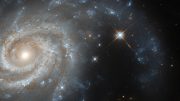


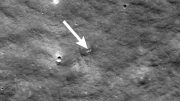

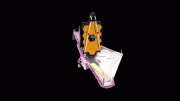


Be the first to comment on "Webb’s Stellar Sleuthing: Unlocking the Secrets of a “Hot Saturn” and Its Spotted Star"